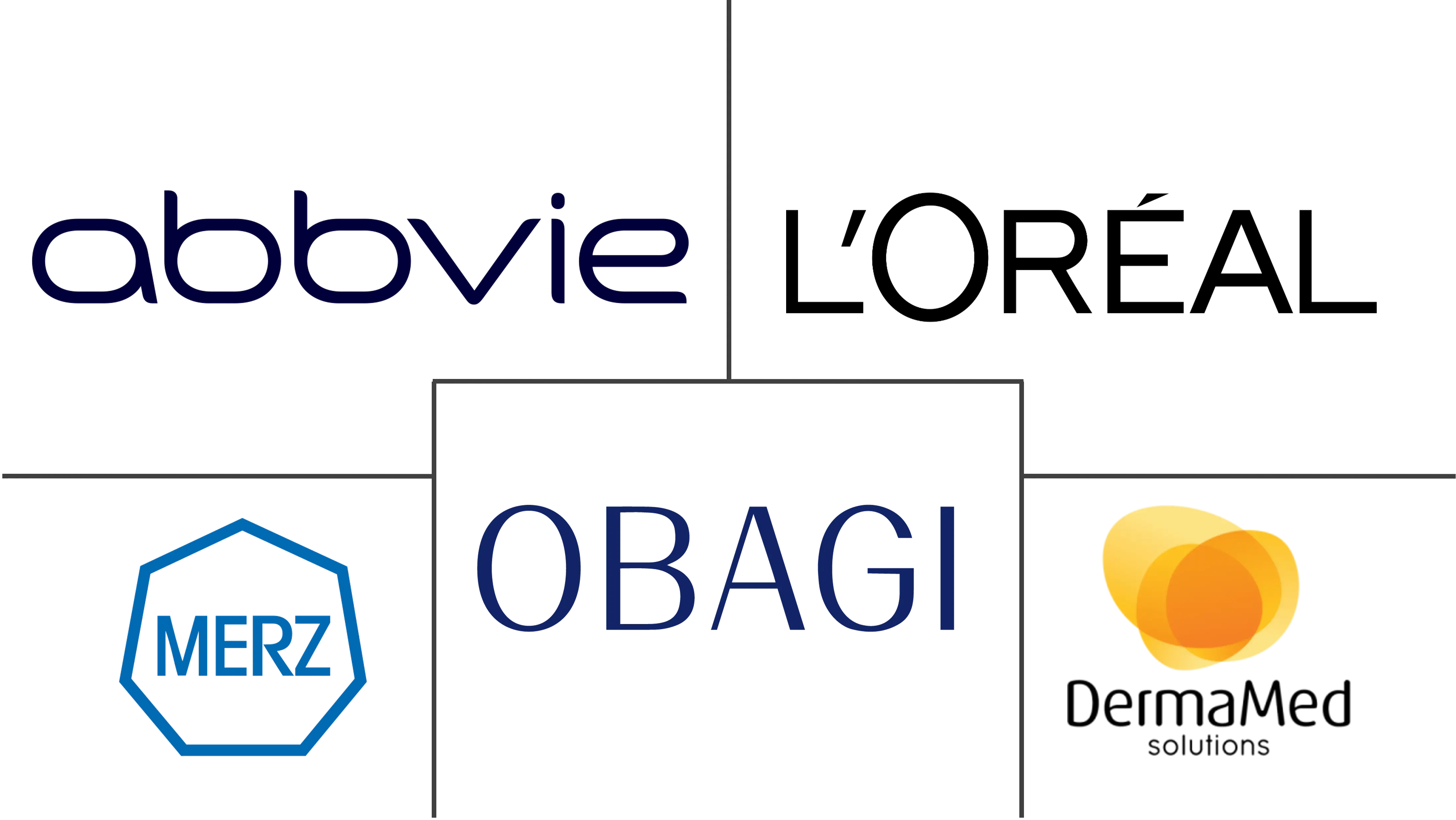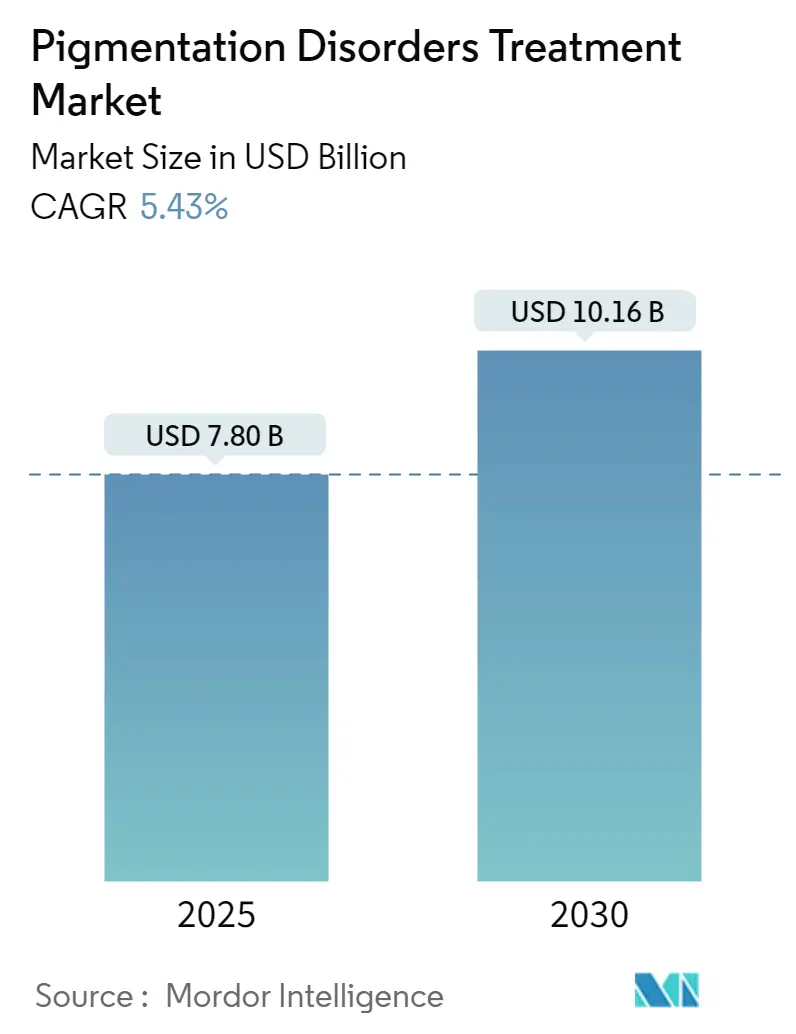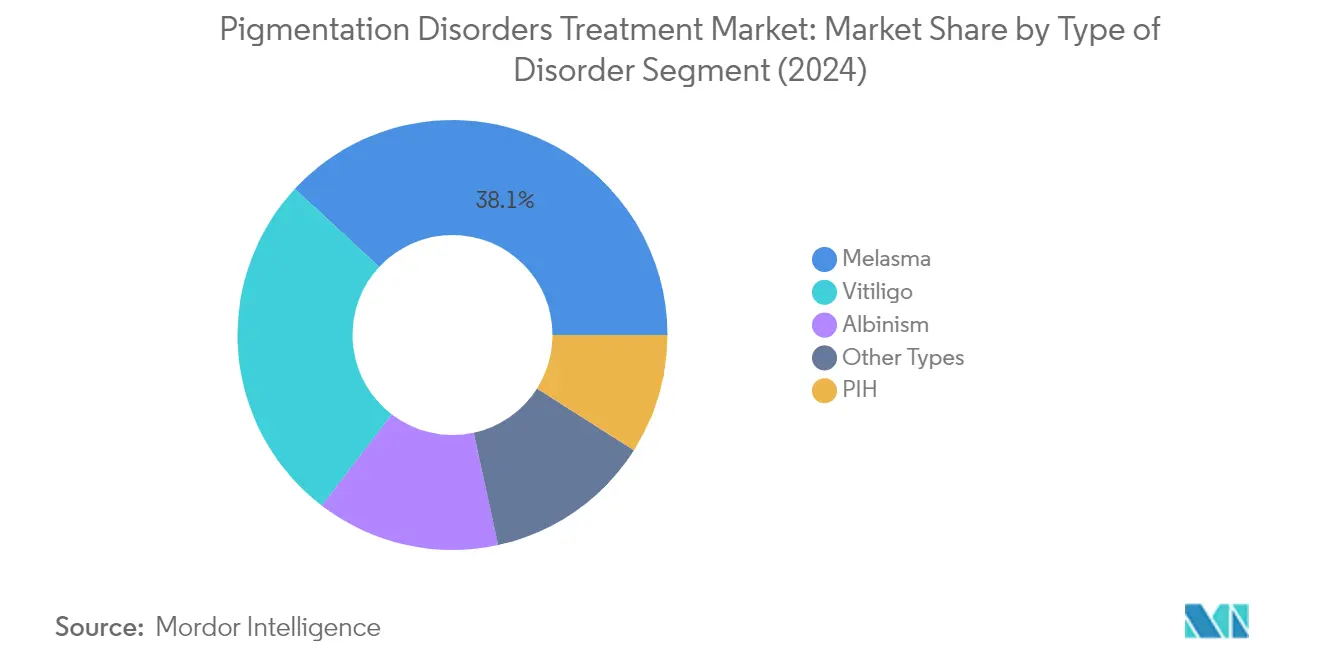Pigmentation Disorders Treatment Market Analysis
The Pigmentation Disorders Treatment Market size is estimated at USD 7.80 billion in 2025, and is expected to reach USD 10.16 billion by 2030, at a CAGR of 5.43% during the forecast period (2025-2030).
The pigmentation disorders treatment market landscape has evolved significantly with technological advancements in treatment modalities and delivery systems. The rapid development of nano-drug delivery systems has introduced new perspectives in treatment approaches, particularly enhancing therapeutic efficiency while reducing side effects. These innovations have led to the development of sophisticated treatment options, including advanced laser therapies, chemical peels, and phototherapy solutions that offer more precise and targeted treatment for hyperpigmentation approaches for various pigmentation conditions.
The industry has witnessed substantial consolidation through strategic partnerships and acquisitions, reflecting the market's maturity and competitive intensity. Notable developments include L'Oréal's acquisition of Takami Co. in February 2021, which strengthened their position in the premium skincare segment, particularly in treating pigmentation disorders. Similarly, the establishment of The Skin Science Foundation (SSF) in Geneva represents a significant collaboration between major industry players and research institutions, demonstrating the industry's commitment to advancing skincare science and treatment of pigmentation options.
Research and development activities have intensified, focusing on developing innovative treatment solutions for various pigmentation disorders. According to a research article published in Karger Journal, pigmentary disorders rank as the third and fourth most common dermatoses in Blacks and Hispanics respectively, highlighting the significant market opportunity in these demographic segments. This has prompted pharmaceutical companies to invest in developing targeted solutions for different ethnic groups, considering their specific skin characteristics and treatment needs.
The market is characterized by a strong focus on product innovation and expansion of treatment options. For instance, in October 2021, Uniza Healthcare launched Vitellus, a specialized lotion for managing Vitiligo in the Indian market, through a collaborative effort with Lucas Meyer Cosmetics and Amvigor Organics. This trend of cross-border collaborations and product innovations continues to shape the market landscape, with companies increasingly focusing on developing comprehensive treatment for skin pigmentation solutions that combine multiple therapeutic approaches for enhanced efficacy. The growth of the hyperpigmentation disorders treatment market is driven by these innovations and strategic partnerships.
Pigmentation Disorders Treatment Market Trends
Increasing Prevalence of Pigmentation Disorders
The rising incidence of various pigmentation disorders globally has become a significant market driver, with conditions ranging from vitiligo and albinism to melasma and post-inflammatory hyperpigmentation. According to recent estimates, the average prevalence of vitiligo affects between 0.5% and 2% of the world population, though local numbers may vary significantly from 0.004% to 9.98% depending on the region and age group. The prevalence of albinism shows notable variation across different regions, with particularly high incidence rates in Sub-Saharan Africa (between 1 in 5,000 and 1 in 15,000 people) and in specific ethnic groups such as the Bhatti Tribe in Pakistan (5 in 100 people) and the Kuna people in Panama (between 5 and 10 in 100 people).
The aging population worldwide has contributed significantly to the increasing prevalence of pigmentation disorders, as skin becomes more susceptible to pigmentary changes with age. According to recent research published in the International Journal of Molecular Sciences, every ten years, the number of melanocytes that produce melanin per unit of skin surface decreases by approximately 10% to 20%. Additionally, studies have shown that 20% to 30% of women aged 40 to 65 years in India have facial melasma, indicating the substantial impact of these conditions on specific demographic groups. The high incidence of melasma has been particularly noted among Latin Americans, Hispanics, and Asians with Fitzpatrick skin types III to V, demonstrating the widespread nature of pigmentation disorders across different ethnic groups and geographical regions. The demand for effective treatment for skin discoloration solutions is thus on the rise, as individuals seek advanced therapy for pigmentation options to manage these conditions.
Growing Expenditure on Dermatological Treatments
The substantial increase in healthcare spending on dermatological treatments has emerged as a crucial driver for the pigmentation disorders treatment market, reflected in both institutional and consumer expenditure patterns. According to recent data from the Aesthetic Plastic Surgery National Databank, skin treatment procedures including chemical peels and hydro facials accounted for 1,390,149 procedures in 2021, while combination laser-based skin treatments reached 431,485 procedures, demonstrating the significant financial commitment to advanced dermatological treatments. This growing expenditure is further evidenced by the increasing investment in research and development, with various institutions and companies allocating substantial resources to develop innovative treatment for hyperpigmentation solutions.
The market has witnessed significant financial commitments in research and development, exemplified by initiatives such as the Wellcome Trust/DBT India Alliance's Intermediate Fellowship Award of Rs 3.60 crore for research on pigmentary disorders. The increasing sophistication of treatment options has led to higher consumer willingness to invest in advanced therapeutic solutions. This trend is supported by the rising number of clinical trials and research studies, with multiple institutions conducting extensive research programs to develop more effective treatment options. The market has also seen substantial investments in new product development and launches, with companies introducing innovative solutions such as sophisticated laser treatments, advanced topical medications, and combination therapies, reflecting the growing economic commitment to addressing pigmentation disorders. The introduction of treatment for skin pigmentation and treatment for pigmentation options is a testament to the industry's dedication to providing comprehensive care solutions.
Segment Analysis: Type of Disorder
Melasma Segment in Pigmentation Disorders Treatment Market
The Melasma segment continues to dominate the global pigmentation treatment market, commanding approximately 38% of the total market share in 2024. This significant market position is attributed to the high prevalence of melasma, particularly among women and individuals with darker skin types. The segment's dominance is further strengthened by the availability of various treatment options, including topical medications, chemical peels, and laser treatments. The increasing awareness about melasma treatment options, coupled with the growing demand for combination therapies involving hydroquinone, tretinoin, and corticosteroids, has contributed to maintaining this segment's leading position in the market.
Vitiligo Segment in Pigmentation Disorders Treatment Market
The vitiligo therapeutics market segment is emerging as the fastest-growing segment in the pigmentation disorders treatment market, projected to grow at approximately 7% CAGR during 2024-2029. This robust growth is driven by significant advancements in treatment modalities, including novel phototherapy techniques and emerging biological therapies. The segment's growth is further fueled by increasing research and development activities focused on developing innovative treatment options, particularly in the areas of targeted immunotherapy and combination treatments. The rising awareness about vitiligo treatment options and improving healthcare infrastructure in developing regions are also contributing to this segment's accelerated growth trajectory.
Remaining Segments in Type of Disorder
The remaining segments in the pigmentation disorders treatment market include Albinism, Post-inflammatory Hyperpigmentation (PIH), and other types of disorders. The Albinism segment maintains a significant presence in the market, driven by the increasing focus on specialized care and management protocols. The PIH segment is gaining traction due to the rising incidence of skin inflammation-related conditions and growing awareness about hyperpigmentation treatment options. Other types of disorders, including conditions like pityriasis alba and progressive macular hypomelanosis, collectively contribute to the market's diversity, with each condition requiring specific treatment approaches and management strategies.
Segment Analysis: Treatment Type
Topical Treatment Segment in Pigmentation Disorders Treatment Market
The topical treatment segment continues to dominate the global skin pigmentation treatment market, holding approximately 46% market share in 2024. This significant market position is attributed to the widespread availability and accessibility of topical medications, including creams, lotions, ointments, and serums formulated with active ingredients like hydroquinone, corticosteroids, retinoids, and kojic acid. The segment's dominance is further strengthened by the increasing preference for non-invasive treatment options and the development of advanced formulations targeting specific pigmentation conditions. Major pharmaceutical companies are actively investing in research and development to introduce innovative topical solutions with enhanced efficacy and reduced side effects, particularly focusing on combination therapies that provide comprehensive treatment approaches for various pigmentation disorders.
Phototherapy Segment in Pigmentation Disorders Treatment Market
The phototherapy segment is emerging as the fastest-growing treatment option in the pigmentation disorders treatment market, projected to grow at approximately 8% during 2024-2029. This remarkable growth is driven by technological advancements in light therapy devices, increasing adoption of narrowband ultraviolet B (NB-UVB) therapy, and growing evidence supporting its effectiveness in treating conditions like vitiligo and other pigmentation disorders. The segment's expansion is further supported by the development of more sophisticated and targeted phototherapy solutions, including combination approaches with other treatment modalities. Healthcare providers are increasingly incorporating phototherapy options into their treatment protocols due to their proven efficacy and relatively lower risk of side effects compared to some alternative treatments.
Remaining Segments in Treatment Type
The pigmentation disorders treatment market encompasses several other significant treatment modalities, including chemical peels, dermabrasion, laser treatment, and various other therapeutic approaches. Chemical peels continue to maintain a strong presence in the market due to their versatility and effectiveness in treating various pigmentation conditions. Dermabrasion treatments are gaining popularity for their ability to provide immediate results in treating superficial pigmentation issues. Laser treatments, while more specialized, offer precise targeting capabilities for specific pigmentation concerns. These segments collectively provide a comprehensive treatment ecosystem, allowing healthcare providers to offer personalized treatment plans based on individual patient needs and condition severity.
Pigmentation Disorders Treatment Market Geography Segment Analysis
Pigmentation Disorders Treatment Market in North America
The North American pigmentation disorders treatment market demonstrates robust growth driven by advanced healthcare infrastructure, high healthcare spending, and increasing awareness about skin conditions. The United States leads the regional market, followed by Canada and Mexico. The region benefits from the presence of major market players, extensive research and development activities, and sophisticated healthcare facilities. The increasing prevalence of various pigmentation disorders, coupled with growing expenditure on dermatological treatments, continues to drive market expansion across these countries.
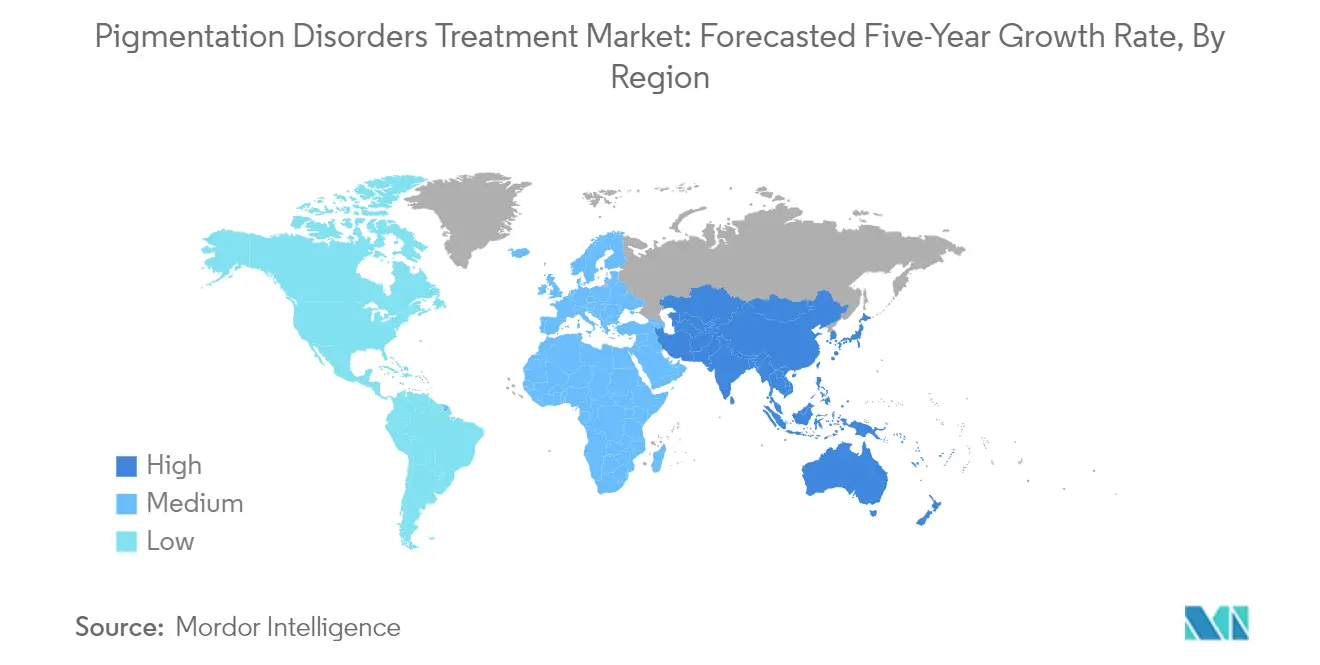
Pigmentation Disorders Treatment Market in United States
The United States dominates the North American market, accounting for approximately 83% of the regional market share in 2024. The country's market leadership is attributed to its advanced healthcare system, high healthcare expenditure, and presence of leading dermatological companies. The market is further strengthened by extensive research activities, with numerous clinical trials focused on developing innovative treatments for treatment of hyperpigmentation disorders. The presence of sophisticated healthcare infrastructure and increasing awareness about skin conditions among the population continues to drive market growth in the country.
Pigmentation Disorders Treatment Market in Canada
Canada emerges as the fastest-growing market in North America, with a projected growth rate of around 7% during 2024-2029. The country's market growth is driven by increasing healthcare expenditure, growing awareness about skin disorders, and improving access to advanced treatment options. The Canadian market benefits from robust healthcare infrastructure and increasing adoption of innovative therapeutic solutions for treatment of pigmentation disorders. The government's supportive healthcare policies and growing focus on dermatological research contribute to the market's expansion.
Pigmentation Disorders Treatment Market in Europe
The European pigmentation disorders treatment market showcases significant growth potential, supported by advanced healthcare systems and increasing investment in dermatological research. The region encompasses key markets including Germany, the United Kingdom, France, Italy, and Spain, each contributing substantially to the overall market growth. The presence of established pharmaceutical companies, advanced research facilities, and increasing awareness about skin disorders drives market expansion across these countries.
Pigmentation Disorders Treatment Market in Germany
Germany maintains its position as the largest market in Europe, representing approximately 21% of the regional market share in 2024. The country's market leadership is attributed to its sophisticated healthcare infrastructure, substantial research and development investments, and presence of major dermatological companies. The German market benefits from advanced treatment facilities, high healthcare spending, and increasing adoption of innovative therapeutic solutions for treatment of pigmentation disorders.
Pigmentation Disorders Treatment Market in Germany
Germany also emerges as the fastest-growing market in Europe, with a projected growth rate of around 8% during 2024-2029. The country's exceptional growth is driven by continuous technological advancements in dermatological treatments, increasing research activities, and growing awareness about skin disorders. The presence of world-class medical facilities and rising investment in healthcare infrastructure further supports market expansion.
Pigmentation Disorders Treatment Market in Asia-Pacific
The Asia-Pacific pigmentation disorders treatment market demonstrates significant growth potential, driven by increasing healthcare expenditure, growing awareness about skin conditions, and improving access to advanced treatments. The region encompasses major markets including China, Japan, India, Australia, and South Korea, each contributing uniquely to market development. The rising prevalence of pigmentation disorders and increasing adoption of advanced therapeutic solutions drives market expansion across these countries.
Pigmentation Disorders Treatment Market in Japan
Japan maintains its position as the largest market in the Asia-Pacific region. The country's market leadership is attributed to its advanced healthcare infrastructure, high healthcare spending, and significant research and development activities in dermatological treatments. The Japanese market benefits from sophisticated medical facilities, increasing awareness about skin disorders, and the presence of leading pharmaceutical companies.
Pigmentation Disorders Treatment Market in India
India emerges as the fastest-growing market in the Asia-Pacific region. The country's exceptional growth is driven by increasing healthcare expenditure, growing awareness about skin disorders, and improving access to advanced treatment options. The Indian market benefits from a large patient pool, rising disposable income, and increasing adoption of innovative therapeutic solutions for treatment of pigmentation disorders.
Pigmentation Disorders Treatment Market in Middle East & Africa
The Middle East & Africa pigmentation disorders treatment market shows steady growth potential, driven by improving healthcare infrastructure and increasing awareness about skin conditions. The region encompasses various markets including GCC countries and South Africa, with GCC emerging as both the largest and fastest-growing market in the region. The market benefits from increasing healthcare expenditure, growing medical tourism, and rising adoption of advanced dermatological treatments. The presence of modern healthcare facilities in major urban centers and increasing investment in healthcare infrastructure contributes to market expansion across the region.
Pigmentation Disorders Treatment Market in South America
The South American pigmentation disorders treatment market demonstrates promising growth potential, supported by improving healthcare infrastructure and increasing awareness about skin conditions. The region includes key markets such as Brazil and Argentina, with Brazil emerging as both the largest and fastest-growing market in the region. The market benefits from increasing healthcare expenditure, growing adoption of advanced dermatological treatments, and rising awareness about skin disorders. The presence of established healthcare facilities in major cities and increasing investment in medical infrastructure contributes to market expansion across the region.
Pigmentation Disorders Treatment Industry Overview
Top Companies in Pigmentation Disorders Treatment Market
The pigmentation disorder treatment market is characterized by continuous product innovations across treatment categories, particularly in topical treatments and chemical peels. Companies are focusing on developing advanced formulations with enhanced efficacy and safety profiles while simultaneously expanding their geographical presence through strategic partnerships and distribution agreements. Major players are investing significantly in research and development to introduce novel therapeutic approaches, including combination therapies and personalized treatment solutions. The industry has witnessed a trend towards operational agility, with companies adopting flexible manufacturing and distribution models to meet varying regional demands. Strategic moves have largely centered around portfolio diversification through both organic growth and acquisitions, particularly in emerging markets where demand for pigmentation disorder treatment market solutions is rising. Additionally, market leaders are emphasizing digital transformation and direct-to-consumer channels to enhance market penetration and customer engagement.
Dynamic Market Structure with Strong Consolidation
The pigmentation disorders treatment market exhibits a mix of global pharmaceutical conglomerates and specialized dermatology companies, with the former leveraging their extensive research capabilities and distribution networks, while the latter focus on niche therapeutic solutions. Global players like AbbVie (through Allergan), L'Oréal, and Pfizer maintain significant market presence through their established brands and comprehensive product portfolios, while regional specialists contribute to market dynamics through targeted innovations and local market expertise. The market structure is characterized by ongoing consolidation through mergers and acquisitions, as evidenced by strategic moves such as AbbVie's acquisition of Allergan and various smaller transactions aimed at strengthening market positions and expanding therapeutic offerings.
The competitive landscape is further shaped by the presence of strong regional players, particularly in Asia-Pacific and Europe, who have developed a deep understanding of local market needs and regulatory requirements. Merger and acquisition activities have been particularly pronounced in the dermatology segment, with companies seeking to expand their technological capabilities and geographic reach. The market has witnessed a trend towards vertical integration, with larger companies acquiring smaller innovative firms to enhance their research and development capabilities while maintaining control over the value chain. This consolidation trend is expected to continue as companies seek to achieve economies of scale and expand their market presence.
Innovation and Market Access Drive Success
Success in the hyperpigmentation treatment market increasingly depends on companies' ability to develop innovative solutions while maintaining strong market access strategies. Incumbent players are focusing on strengthening their research and development capabilities, expanding their product portfolios through both internal development and strategic acquisitions, and establishing strong relationships with healthcare providers and distributors. Market leaders are also investing in real-world evidence generation and patient engagement programs to demonstrate treatment value and improve outcomes. The ability to navigate complex regulatory environments while maintaining competitive pricing strategies has become crucial for maintaining market share.
For contenders looking to gain ground, differentiation through technological innovation and specialized therapeutic approaches presents significant opportunities. Success factors include developing novel delivery systems, establishing strong clinical evidence bases, and building efficient distribution networks. Companies must also consider the increasing role of digital health solutions and personalized medicine in treatment approaches. The skin disease treatment market is characterized by moderate substitution risk, primarily from alternative treatment methods and home remedies, necessitating strong value proposition communication to healthcare providers and patients. Regulatory compliance remains a critical success factor, particularly as authorities worldwide increase scrutiny of dermatological products and treatments.
Pigmentation Disorders Treatment Market Leaders
-
Dermamed Solutions
-
AbbVie Inc (Allergan, Inc)
-
Obagi Cosmeceuticals LLC
-
Merz GmbH & Co. KGaA
-
L'Oréal SA
- *Disclaimer: Major Players sorted in no particular order
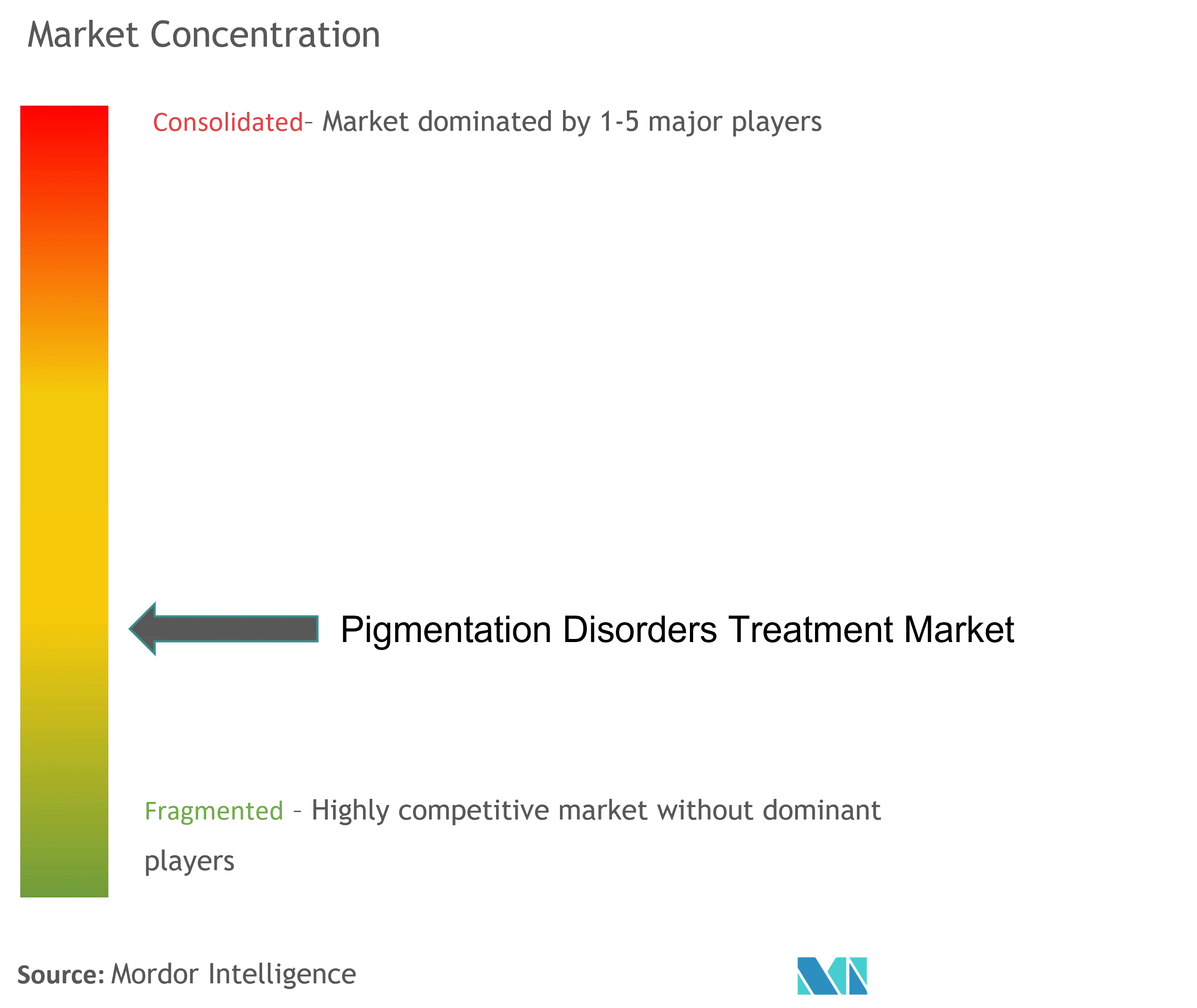
Pigmentation Disorders Treatment Market News
- July 2022: Incyte Corporation received approval from the United States Food and Drug Administration for Opzelura (ruxolitinib) cream for treating non-segmental vitiligo in adult and pediatric patients 12 years of age and older.
- June 2022: Ahammune Biosciences Private Limited and Veeda Clinical Research Limited of India signed a collaboration deal for the human trials of AB1001, an experimental novel medication developed by Ahammune as a topical therapy for vitiligo.
Pigmentation Disorders Treatment Market Report - Table of Contents
1. INTRODUCTION
- 1.1 Study Assumptions & Market Definition
- 1.2 Scope Of The Study
2. RESEARCH METHODOLOGY
3. EXECUTIVE SUMMARY
4. MARKET DYNAMICS
- 4.1 Market Overview
-
4.2 Market Drivers
- 4.2.1 Increasing Prevalence of Pigmentation Disorders
- 4.2.2 Growing Expenditure on Dermatalogical Treatments
-
4.3 Market Restraints
- 4.3.1 High Cost of Cosmetic Procedures
- 4.3.2 Inadequate Reimbursement Policies
-
4.4 Industry Attractiveness - Porter's Five Forces Analysis
- 4.4.1 Threat of New Entrants
- 4.4.2 Bargaining Power of Buyers
- 4.4.3 Bargaining Power of Suppliers
- 4.4.4 Threat of Substitute Products
- 4.4.5 Intensity of Competitive Rivalry
5. MARKET SEGMENTATION (Market Size by Value - USD Million)
-
5.1 By Type of Disorder
- 5.1.1 Albinism
- 5.1.2 Vitiligo
- 5.1.3 Melasma
- 5.1.4 Post-inflammatory Hyperpigmentation (PIH)
- 5.1.5 Other Types of Disorders
-
5.2 By Treatment Type
- 5.2.1 Topical Treatment
- 5.2.2 Dermabrasion
- 5.2.3 Chemical Peels
- 5.2.4 Laser Treatment
- 5.2.5 Phototherapy
- 5.2.6 Other Treatment Types
-
5.3 By Geography
- 5.3.1 North America
- 5.3.1.1 United States
- 5.3.1.2 Canada
- 5.3.1.3 Mexico
- 5.3.2 Europe
- 5.3.2.1 Germany
- 5.3.2.2 United Kingdom
- 5.3.2.3 France
- 5.3.2.4 Italy
- 5.3.2.5 Spain
- 5.3.2.6 Rest of Europe
- 5.3.3 Asia-Pacific
- 5.3.3.1 China
- 5.3.3.2 Japan
- 5.3.3.3 India
- 5.3.3.4 Australia
- 5.3.3.5 South Korea
- 5.3.3.6 Rest of Asia-Pacific
- 5.3.4 Middle East and Africa
- 5.3.4.1 GCC
- 5.3.4.2 South Africa
- 5.3.4.3 Rest of Middle East and Africa
- 5.3.5 South America
- 5.3.5.1 Brazil
- 5.3.5.2 Argentina
- 5.3.5.3 Rest of South America
6. COMPETITIVE LANDSCAPE
-
6.1 Company Profiles
- 6.1.1 AbbVie Inc. (Allergan Inc.)
- 6.1.2 Epionce
- 6.1.3 DermaMed Solutions LLC
- 6.1.4 L'Oreal SA
- 6.1.5 Pierre Fabre Group (Pierre Fabre Laboratories)
- 6.1.6 Vital Esthetique
- 6.1.7 Obagi Cosmeceuticals LLC
- 6.1.8 Pfizer Inc.
- 6.1.9 Galderma SA
- 6.1.10 Merz GmbH & Co. KGaA
- 6.1.11 Candela Corporation
- 6.1.12 SkinCeuticals
- *List Not Exhaustive
7. MARKET OPPORTUNITIES AND FUTURE TRENDS
Pigmentation Disorders Treatment Industry Segmentation
Pigmentation disorders comprise many diverse conditions that are usually characterized by altered melanocyte density, melanin concentration, or both, resulting in altered skin pigmentation. Pigmentation disorders are classified into hypopigmentation and hyperpigmentation.
The Pigmentation Disorders Treatment Market is Segmented by Type of Disorder (Albinism, Vitiligo, Melasma, Post-inflammatory Hyperpigmentation (PIH), and Other Types of Disorders), Treatment Type (Topical Treatment, Dermabrasion, Chemical Peels, Laser Treatment, Phototherapy, and Other Treatment Types), and Geography (North America, Europe, Asia-Pacific, Middle East and Africa, and South America). The report also covers the estimated market sizes and trends for 17 different countries across major regions globally. The report offers the value (in USD million) for the above segments.
| By Type of Disorder | Albinism | ||
| Vitiligo | |||
| Melasma | |||
| Post-inflammatory Hyperpigmentation (PIH) | |||
| Other Types of Disorders | |||
| By Treatment Type | Topical Treatment | ||
| Dermabrasion | |||
| Chemical Peels | |||
| Laser Treatment | |||
| Phototherapy | |||
| Other Treatment Types | |||
| By Geography | North America | United States | |
| Canada | |||
| Mexico | |||
| Europe | Germany | ||
| United Kingdom | |||
| France | |||
| Italy | |||
| Spain | |||
| Rest of Europe | |||
| Asia-Pacific | China | ||
| Japan | |||
| India | |||
| Australia | |||
| South Korea | |||
| Rest of Asia-Pacific | |||
| Middle East and Africa | GCC | ||
| South Africa | |||
| Rest of Middle East and Africa | |||
| South America | Brazil | ||
| Argentina | |||
| Rest of South America | |||
Pigmentation Disorders Treatment Market Research FAQs
How big is the Pigmentation Disorders Treatment Market?
The Pigmentation Disorders Treatment Market size is expected to reach USD 7.80 billion in 2025 and grow at a CAGR of 5.43% to reach USD 10.16 billion by 2030.
What is the current Pigmentation Disorders Treatment Market size?
In 2025, the Pigmentation Disorders Treatment Market size is expected to reach USD 7.80 billion.
Who are the key players in Pigmentation Disorders Treatment Market?
Dermamed Solutions, AbbVie Inc (Allergan, Inc), Obagi Cosmeceuticals LLC, Merz GmbH & Co. KGaA and L'Oréal SA are the major companies operating in the Pigmentation Disorders Treatment Market.
Which is the fastest growing region in Pigmentation Disorders Treatment Market?
Asia-Pacific is estimated to grow at the highest CAGR over the forecast period (2025-2030).
Which region has the biggest share in Pigmentation Disorders Treatment Market?
In 2025, the North America accounts for the largest market share in Pigmentation Disorders Treatment Market.
What years does this Pigmentation Disorders Treatment Market cover, and what was the market size in 2024?
In 2024, the Pigmentation Disorders Treatment Market size was estimated at USD 7.38 billion. The report covers the Pigmentation Disorders Treatment Market historical market size for years: 2021, 2022, 2023 and 2024. The report also forecasts the Pigmentation Disorders Treatment Market size for years: 2025, 2026, 2027, 2028, 2029 and 2030.
Our Best Selling Reports
Pigmentation Disorders Treatment Market Research
Mordor Intelligence provides a comprehensive analysis of the pigmentation disorders treatment market, drawing on our extensive experience in healthcare market research. Our latest report explores a wide range of conditions, including hyperpigmentation treatment, hypopigmentation disorder treatment, and vitiligo treatment. The analysis covers various therapeutic approaches, from skin pigmentation treatment solutions to emerging medications like Opzelura. This includes markets such as the UAE and Chile, offering stakeholders detailed insights into treatment innovations and market dynamics.
The report delivers valuable intelligence for stakeholders in the skin discoloration treatment sector. It provides in-depth coverage of pigmentation therapy approaches and melasma treatments. Our analysis includes a detailed examination of hyperpigmentation disorders treatment market growth trends, available as an easy-to-download report PDF. The research covers both established and emerging solutions, including skin disease treatment modalities, pigmentation disorders treatment protocols, and specialized vitiligo therapeutics. This enables healthcare providers, pharmaceutical companies, and investors to make informed strategic decisions.

